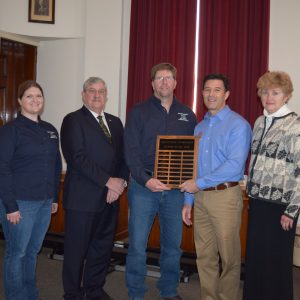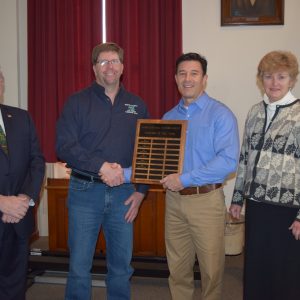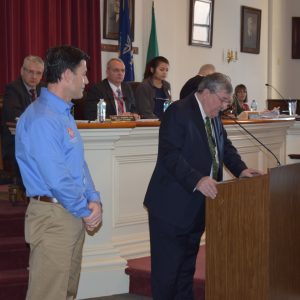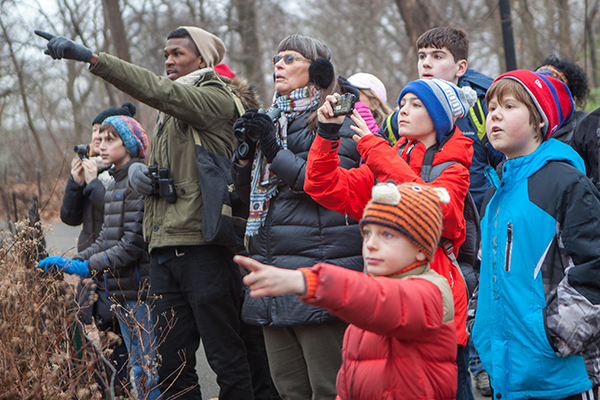District Manger, Lindsey Gerstenslager wrote in the Conservation corner “The final month of the year is always a good time for reflection about a year full of conservation and boots-on-the-ground efforts. This year’s memories continue to highlight so much hard work throughout all of the communities of Wayne County. With over 45,000 contacts across all of the District programs for technical assistance, it leaves a great deal of conversations about conservation and how to make our communities sustainable and stronger. Partnership and principle knowledge are the foundation of all efforts for the District throughout 2016. This year was a challenging year for water quality, erosion control, and soil health management due to weather conditions. From devastating floods in 2015 to drought conditions occurring over 50% of the County, left many in the community with numerous concerns. Because of the unwavering determination of this community, the members pushed forward on several projects with the District ready for action, but short on staff for 2017. Due to the success of in-state and grant funding efforts, the District was able to leverage local funding to begin to expand efforts to newly observed areas of concern including protecting Lake Ontario coastal infrastructure, Land Owner Assistance programs, and expansion of the Agriculture Environmental Management program of NYS.Partnership and principle knowledge are the foundation of all efforts for the District throughout 2016.
2016 Wayne County Agriculture Environmental Stewardship
Congratulations to Michael Stanyard of Cornell Cooperative Extension (CCE), the recipient of the 2016 Wayne County Agriculture Environmental Stewardship award Awarding stewardship effort from across the agriculture communities
This year has been a great year for conservation in the agricultural industry in Wayne County. The varying soil types because of water quality considerations sometimes restrict implementation of specific projects that will aid in farms continuing to run their businesses while being considerate environmental health. Many farms were able to implement projects simply because crops were able to be planted early to on time.
Over the past several years, the District has awarded an Agricultural Environmental Stewardship award to a member of the agricultural support community that goes above and beyond to continue to provide services and manage environmental issues, aid in dealing with the difficult years and lend a hand to other farms. The award was created to be given at a grassroots level, to individuals that strengthen the community.
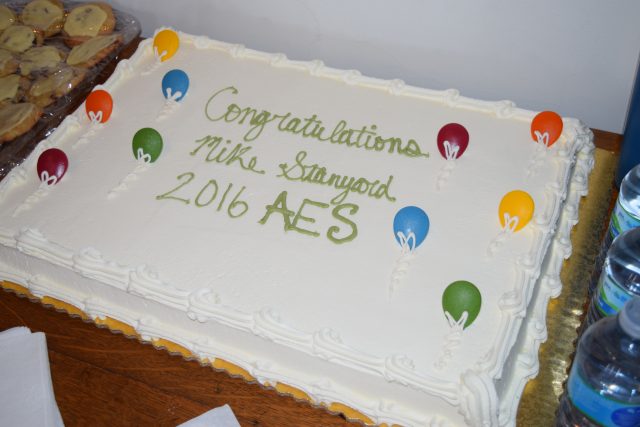 This year’s award recipient was awarded to Michael Standard, Team Leader, Field Crops Specialist of the Northwest New York Dairy, Livestock & Field Crop Team, Cornell Cooperative Extension of Wayne County on Tuesday, December 20, 2016 with recognition by the County Board of Supervisors, located at Wayne County Court House Chambers, 26 Church Street, Lyons, NY 14489.
This year’s award recipient was awarded to Michael Standard, Team Leader, Field Crops Specialist of the Northwest New York Dairy, Livestock & Field Crop Team, Cornell Cooperative Extension of Wayne County on Tuesday, December 20, 2016 with recognition by the County Board of Supervisors, located at Wayne County Court House Chambers, 26 Church Street, Lyons, NY 14489.
Mr. Stanyard has been supporting Wayne County agricultural communities while continuing to address environmental related issues including but not limited to: soil health, cover crops, integrated pest management, crop disease management, climate resiliency, commodity marketing research, crop typing, organization of technical Ag teams, agricultural business planning, discussion groups, agriculture water quality management and so much more.
He continues to be an active participate in the Wayne County Agriculture Advisory Committee for 5 years and has assisted farms in relation to USDA and Wayne County Soil & Water Conservation Programs through the local working group. He advisement is available and offers outreach for any community member or group that requests it. His continued interest in the world of insects has provided technical assistance in addressing issues within Wayne County. Because Mike is a resident of Wayne County, honoring him with this award is extra special, as he continues to take part in efforts of Agro forestry, and wildlife conservation planning, along with the continuation of education with the youth.
We honor Mike as the 2016 Wayne County Agriculture Environmental Stewardship recipient because of his dedication and continue passion for leading the Wayne County Agricultural Community into the future.
Fun at Montezuma Audubon Center
Join volunteers from Montezuma Audubon Center at Buttonwood Grove Winery for a guided snowshoe hike along the gorge trail, wine and cheese pairings and a live bird of prey presentation. Saturday, February 4 at 11:00 AM – 2:00 PM EST Space is limited. PRE-PAID RESERVATIONS REQUIRED prior to February 1st.
Fee with snowshoe rental: $30/adult, $20/child.
Fee without snowshoe rental: $25/adult, $15/child.
Address: 2295 NY-89, Savannah, NY 13146
Phone: (315) 365-3580
Christmas Bird Count
Looking for a new holiday tradition? How about the national Audubon Christmas Bird Count?
The Christmas Bird Count (CBC) will take place at the Montezuma Audubon Center located at 2295 State Route 89, Savannah, NY 13146 at 5:00 pm on Monday, December 19.
This is a long-standing program of the National Audubon Society, with over 100 years of citizen science involvement. It is an early-winter bird census where thousands of volunteers across the US, Canada and many countries in the Western Hemisphere go out over a 24-hour period on one calendar day to count birds. As the Christmas Bird Count enters its 117th year, birders of all experience levels are encouraged to join us to count Montezuma’s wintering birds.
This event is free and open to the public but registration is required by calling 315-365-3588. http://friendsofmontezuma.org/event/montezuma-christmas-bird-count/
The Montezuma Wetlands Complex is a globally significant Important Bird Area (IBA), contains numerous intriguing habitats: Lake, River, Deciduous Hardwoods, Open Field, Coniferous Stands, Fresh Water Marsh, and Grassland.
The compilation will take place at the Montezuma Audubon Center located at 2295 State Route 89, Savannah, NY 13146 at 5:00 pm on Monday, December 19.
There is a specific methodology to the CBC, and all participants must make arrangements to participate in advance with the circle compiler within an established circle, but anyone can participate.
Each count takes place in an established 15-mile wide diameter circle, and is organized by a count compiler. Count volunteers follow specified routes through a designated 15-mile (24-km) diameter circle, counting every bird they see or hear all day. It’s not just a species tally–all birds are counted all day, giving an indication of the total number of birds in the circle that day.
If you are a beginning birder, you will be able to join a group that includes at least one experienced birdwatcher. … more
Cover Crop Workshop
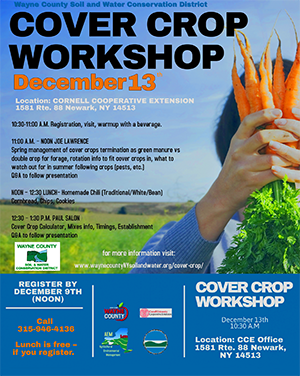 Wayne County Soil and Water Conservation District will be holding a free ‘Soil Health’ workshop on December 13, 2016 at the Cornell Cooperative Extension offices in Newark, NY.
Wayne County Soil and Water Conservation District will be holding a free ‘Soil Health’ workshop on December 13, 2016 at the Cornell Cooperative Extension offices in Newark, NY.
To register for the workshop, or if you have any questions call 315-946-4136. Please RSVP by December 9th at noon. For more information, visit www.waynecountynysoilandwater.org/cover-crop/
or contact Ian Priestley, AEM Specialist at Priestleyswcd@rochester.rr.com
This workshop will provide information to farmers that will allow them to better understand how to incorporate cover crops successfully into their agricultural systems, and why cover crops can be so beneficial to soil health and natural resource conservation.
Farmers know that good soil health is increasingly important. Soil erosion and sedimentation are one of the major problems farmers face. It takes 500 years to replenish just one inch of topsoil. The use of cover crops can help farmers by reducing the loss of a precious percentage of soil each year. Besides protection from wind and water erosion, some of the other benefits of cover crops, include the fact that they can reduce the impact of insects and soil disease pressure. Cover crops may lessen the presence of weeds, and can often build soil organic matter which help reduce soil compaction. In addition to helping to conserve soil, live cover crops allow for energy for soil microbes to recycle and store nutrients and build soil carbon and organic matter, saving fertilizer costs by scavenging nutrients or adding nitrogen to the soil through fixation. Cover crops protect water quality by reducing phosphorus runoff.
Warm-up with a beverage starting at 10:30 A.M. Morning (11am-12pm) and afternoon (12:30-1:30) speakers include Joe Lawrence, Cornell University. Joe will discuss spring management of cover crops, termination as green manure vs double crop for forage, rotation and what to watch out for in summer following crops (pests, etc.). Paul Salon of the NRCS will talk about crop establishment, use of the cover crop calculator, mixes info and the timing of crops. Each segment will include a discussion and Q&A. Local farmers are encouraged to attend to share success stories on planting cover crops, how to get started using them, and the results they see on their farms.
Following the morning session there will be a free lunch of homemade chili, (Traditional/White/Bean) cornbread, chips & cookies.
To register for the workshop, or if you have any questions call 315-946-4136. Please RSVP by December 9th at noon. For more information, visit www.waynecountynysoilandwater.org/cover-crop/
or contact Ian Priestley, AEM Specialist at Priestleyswcd@rochester.rr.com
Workshop partners include NY Wayne County, Cornell Cooperative Extension, NYS DEC, Agricultural Environmental Management (AEM).
Land Owner Workshop for property owners who have Eastern hemlocks
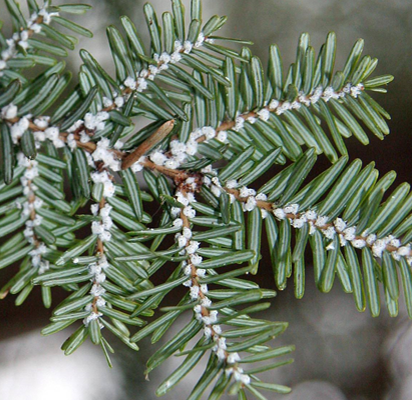 Land Owner Workshop for property owners who have Eastern hemlocks growing on their properties is scheduled for Saturday, December 3, 2016 at the Naples Village Hall, 108 South Main Street (Rte. 21), Naples from 10 am until noon.
Land Owner Workshop for property owners who have Eastern hemlocks growing on their properties is scheduled for Saturday, December 3, 2016 at the Naples Village Hall, 108 South Main Street (Rte. 21), Naples from 10 am until noon.
Hemlock Woolly Adelgid (HWA) is an aphid-like insect native to Asia. It was first recognized in the Eastern U.S. in Virginia in 1950’s, and reached New York in the 1980
The HWA is spread by the wind, by birds, or by humans or other animals- infestations do not spread by flying HWA. HWA produce two generations a year, and all are female and reproduce asexually. The HWA is active during the winter, which allows it to avoid predators (which are generally active during the summer) and to take advantage of the hemlock’s increased energy intake during the winter.
Read more: http://www.canandaigualakeassoc.org/get-involved/events/
Earthworms in Nature
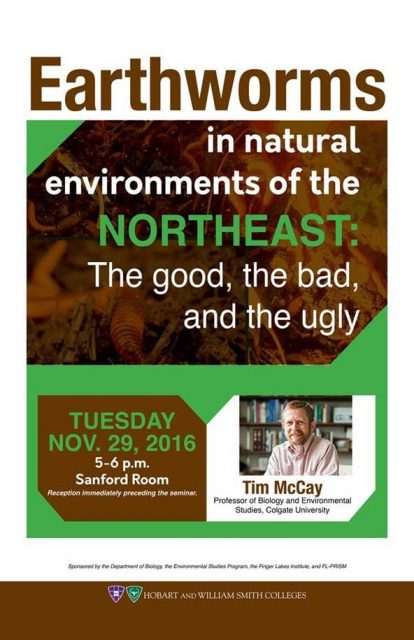 The Department of Biology, the Environmental Studies Program, the Finger Lakes Institute, and FL-PRISM invite you to join them for a co-hosted seminar on Tues. 11/29 (5-6 pm at Hobart Williams University, in the Sanford Room).
The Department of Biology, the Environmental Studies Program, the Finger Lakes Institute, and FL-PRISM invite you to join them for a co-hosted seminar on Tues. 11/29 (5-6 pm at Hobart Williams University, in the Sanford Room).
Dr. Tim McCay of Colgate University will speak about his research on earthworms in the Northeastern U.S.
All are welcome. Refreshments precede the seminar.
Wetland Restoration Funds for Sodus Creek – Sodus Bay
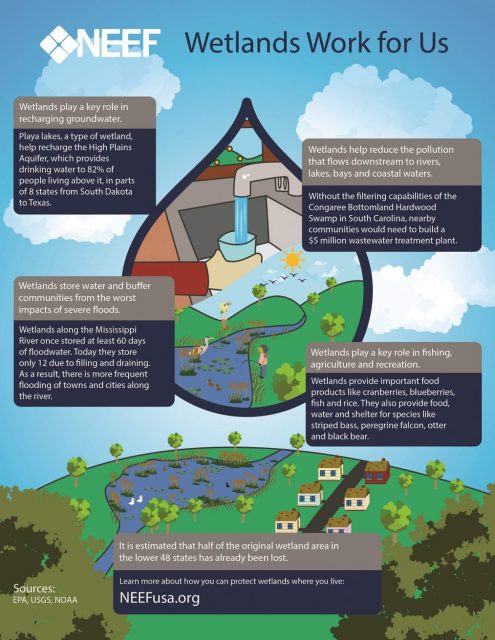 The Nature Conservancy has been awarded a $193,521 grant from the Sustain Our Great Lakes program to restore and enhance more than 115 acres of wetland habitat in Sodus Bay by reconnecting floodplain habitat and assessing road-stream crossings that prevent fish from reaching spawning habitats.
The Nature Conservancy has been awarded a $193,521 grant from the Sustain Our Great Lakes program to restore and enhance more than 115 acres of wetland habitat in Sodus Bay by reconnecting floodplain habitat and assessing road-stream crossings that prevent fish from reaching spawning habitats.
The effort is a partnership among Save our Sodus, the State University of New York College of Environmental Science and Forestry (SUNY-ESF), the Wayne County Soil and Water Conservation District the New York State Department of Environmental Conservation (NYS DEC) and The Nature Conservancy. With contributions from partners and private funders, the total budget for the project amounts to more than $362,000.
“Sustain Our Great Lakes and the Great Lakes Restoration Initiative (GLRI) have been critical partners in protecting wetlands,” said Jim Howe, executive director of The Nature Conservancy’s Central and Western New York Chapter. “Healthy wetlands filter our water, absorb storm surges and provide critical habitat for fish and wildlife. They’re vital to maintaining a healthy Bay and the benefits it provides―recreational boating, fishing, swimming and tourism―to our local economy.
The Nature Conservancy will first assess the effectiveness of 10 existing road stream crossings in improving passage for fish to upstream spawning habitat. Then, beginning in winter 2017 when the wetland mat is still frozen, an excavator will be used to create a more natural wetland with a meandering stream corridor, at least two acres of backwater potholes and new channels that connect streams to their floodplains. The revitalized wetland will offer new and improved habitat for species like northern pike, black ducks, green winged teal, least bitterns and potentially even black terns, a NYS-threatened species that hasn’t been observed breeding in the area in 10 years.
“The southern Sodus Bay wetland is one of only a few remaining coastal wetland complexes in the Lake Ontario basin,” said Gregg Sargis, director of ecological management for The Nature Conservancy. In addition to restoring wetland habitats for fish and wildlife, this project will make the shoreline of Lake Ontario more resilient for people by absorbing storm surge, increasing flood storage and reducing the amount of nutrients and pollutants entering Sodus Bay.”
This wetland restoration project will be a great benefit to the entire watershed community, economically and environmentally,” said Save Our Sodus Board Member Edward Leroux. “Not only will the project benefit fish and wildlife, but the improved functioning of the wetland will significantly reduce nutrient loading from tributaries flowing to the Bay. Projects such as this one are an important contribution to the preservation of our recreation- and tourism-based economy as well as shore owners.
This project will also build upon invasive species management efforts currently underway across Sodus Bay while helping to deepen partnership for the benefit of the region,” said Lindsay Gerstenslager, District Manager for the Wayne County Soil and Water Conservation District. “The District is glad to have worked with many partners to improve water quality and invasive species management over the years, and adding The Nature Conservancy to these efforts will broaden our scope and expertise.”
“We are excited to work with The Nature Conservancy on this important project,” added Gregory Boyer, Director of Great Lakes Research and Professor of Biochemistry at SUNY-ESF. “While this project will improve fish habitat in the wetlands, we are hoping it will have an equally important role in limiting the nutrients entering Sodus Bay via Sodus Creek. This should lead to long-term benefits such as improved water quality and a reduction in harmful algal blooms that have plagued the Bay in past years.”
Additional private funds will be needed to complete this vital environmental restoration initiative. The Helen & Ritter Shumway Foundation has provided a grant in support of the effort, and The Nature Conservancy will be looking to raise additional funds over the next year.
Sustain Our Great Lakes is a public–private partnership that supports habitat restoration in the Great Lakes basin. Administered by the National Fish and Wildlife Foundation, a significant portion of program funding is provided by the Great Lakes Restoration Initiative (GLRI), a federal program designed to protect, restore and enhance the Great Lakes ecosystem. In 2016, the Sustain Our Great Lakes program awarded The Nature Conservancy $1.19 million for Great Lakes coastal wetland conservation projects in Indiana, Illinois, Wisconsin and New York.
Full press release can be found here.
PRESS: The Nature Conservancy and Partners to Restore Sodus Bay Wetlands for People and Nature Sustain Our Great Lakes grant will help revitalize more than 115 acres of coastal wetland habitat along Sodus Bay
Contacts:
November 15, 2016 Contact: Kate Frazer
For Immediate Release Communications Manager
kfrazer@tnc.org, cell: 339-222-2014
Whooooo is coming to Happy Owl-ween this Saturday from 6 pm – 8 pm
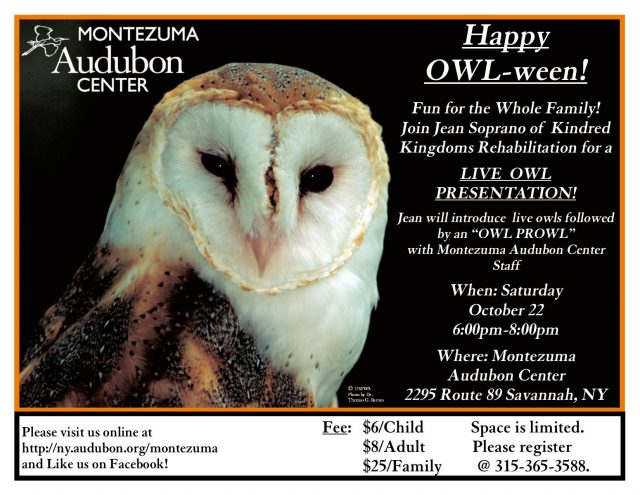 Whooooo is coming to Happy Owl-ween this Saturday from 6 pm – 8 pm at the Montezuma Audubon Center? If YOOOOU join us, you’ll see 5 owls during the indoor presentation and then enjoy a 1-mile hike with our staff to experience the nighttime sights, sounds and smells of Montezuma. Great-horned owls have been hooting it up in our forests so bring the entire family and join us! Cider and donuts will be provided. Fee: $6/child, $8/adult, $25/family. Space is limited and registration is required. Call 315-365-3588 or email montezuma@audubon.org.
Whooooo is coming to Happy Owl-ween this Saturday from 6 pm – 8 pm at the Montezuma Audubon Center? If YOOOOU join us, you’ll see 5 owls during the indoor presentation and then enjoy a 1-mile hike with our staff to experience the nighttime sights, sounds and smells of Montezuma. Great-horned owls have been hooting it up in our forests so bring the entire family and join us! Cider and donuts will be provided. Fee: $6/child, $8/adult, $25/family. Space is limited and registration is required. Call 315-365-3588 or email montezuma@audubon.org.
Climate changes affect local infrastructure – Blind Sodus Bay
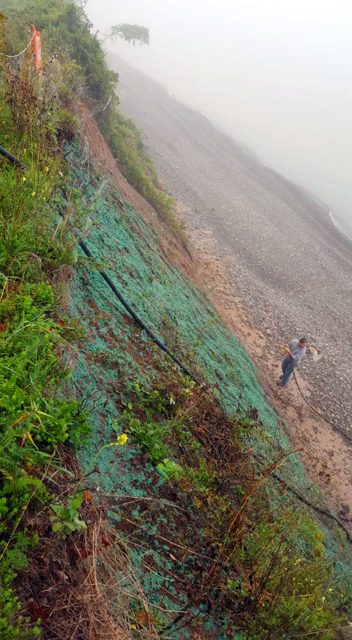 The District began hydro-seeding utilizing an erosion control blanket called Flex Terra HD, made up of biodegradable fiber and supplemented with conservation seed mixed specifically made for fast growth to encourage temporary erosion control on a very steep shoreline slope at the end of Blind Sodus Bay road, on the west side of the Blind Sodus Bay barrier bar a joining Lake Ontario. The residents of this area contacted the Town of Wolcott in August, when it became imminent to them that there was a concern with the loss of the roadway (1 ½ feet from the shoreline), access for public safety vehicles and utility lines, the proximity of the sewer main (12 feet from the shoreline) and potential loss of a barn/storage (15 feet from the shoreline). The shoreline has become a cliff and because it is so close to the road, poses a concern for long term safety for the residents.
The District began hydro-seeding utilizing an erosion control blanket called Flex Terra HD, made up of biodegradable fiber and supplemented with conservation seed mixed specifically made for fast growth to encourage temporary erosion control on a very steep shoreline slope at the end of Blind Sodus Bay road, on the west side of the Blind Sodus Bay barrier bar a joining Lake Ontario. The residents of this area contacted the Town of Wolcott in August, when it became imminent to them that there was a concern with the loss of the roadway (1 ½ feet from the shoreline), access for public safety vehicles and utility lines, the proximity of the sewer main (12 feet from the shoreline) and potential loss of a barn/storage (15 feet from the shoreline). The shoreline has become a cliff and because it is so close to the road, poses a concern for long term safety for the residents.
The Town Supervisor, Lynn Chatfield, contacted the District for some technical assistance. After a few site visits and research, the District decided to use this project to demonstrate some different erosion control materials for water quality and track the amount of growth utilizing the specialize materials for control. From the research, it was determined that roughly 1-1.5 linear feet of the shoreline is being lost annually due to the precipitation and wind erosion mostly because of the soil type during months from November through April. The goal was to provide some stability to the substrate through root systems. The slope has random plants growing along the area and hopefully benefit from this type of erosion control.
The erosion control program run by the District is made available through funding partnership with the Finger Lakes Lake Ontario Watershed Protection Alliance (FLLOWPA) through the New York State Environmental Protection Fund.

